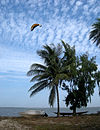Carabane is an island and a village located in the extreme south-west of Senegal, in the mouth of the Casamance River. The earliest known inhabitants of the island were the Jola people, the ethnic group which is still the most populous on the island. On January 22, 1836, the island was ceded to France by the village leader of Kagnout in return for an annual payment of 196 francs. In 1869, Carabane became autonomous, but it merged with Sédhiou in 1886. Since World War II, the population of the island has gradually declined for a variety of reasons including periods of drought, the Casamance Conflict and, more recently, the sinking of the Joola in 2002. Because the Joola was the primary means of travel to and from Carabane, much of the village's ability to trade and receive tourists has been lost. Although Carabane was once a regional capital, the village has since become so politically isolated from the rest of the country that it no longer fits into any category of the administrative structure decreed by the Senegalese government. Although there have been attempts to cultivate a tourism industry on the island, the inhabitants have been reluctant to participate. (more...)
Recently featured: Ice hockey at the Olympic Games – Overman Committee – HMAS Melbourne
